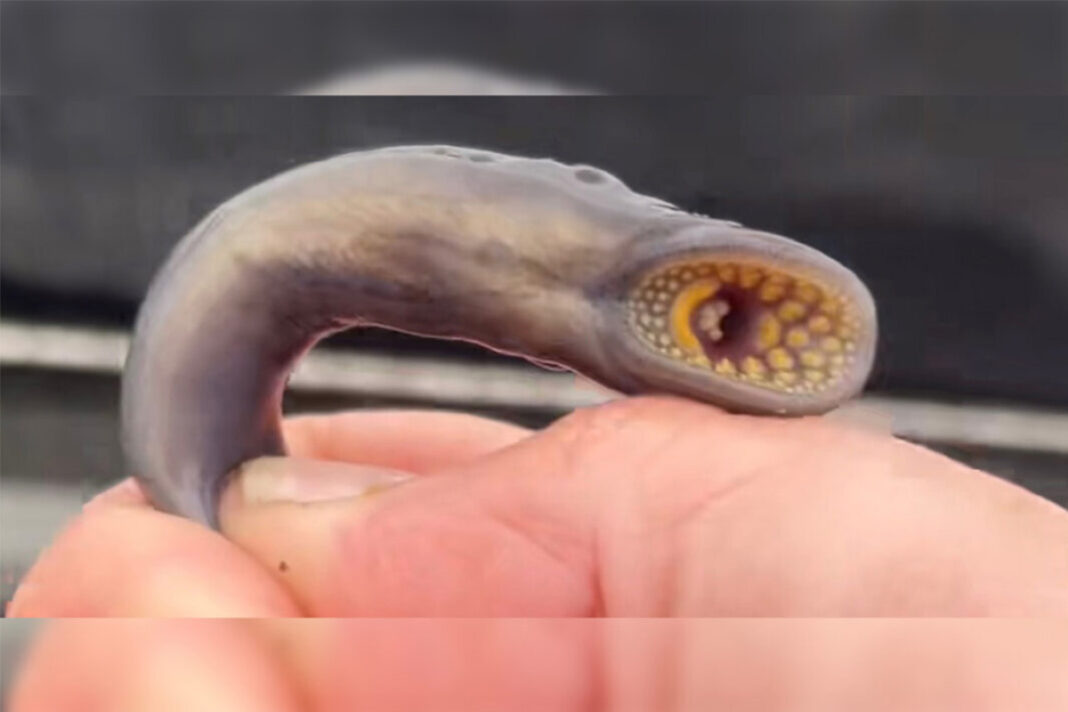GORE BAY—With job cuts made in the United States Great Lakes invasive species program, a local commercial fishing operator and member of the Great Lakes Fishery Commission (GLFC) says that the fishery may end being wiped out by sea lamprey as was the case about 80-90 years ago.
“The fishery in the Great Lakes is worth $7 billion (in America and Canada),” stated George Purvis. He explained sea lamprey were first sighted in the area around 1934. Ten years later, by 1945, lake trout were all gone on the Great Lakes because of sea lamprey.
“I talked to one fisherman one time, and he was telling me that in 1945 he caught one lake trout, weighing 45 pounds, but that was it,” said Mr. Purvis, noting from 1935-1945 the fishery was wiped out. “Canada and the US have stocked about 50 million fish (in recent years). In Lake Huron, at least on the north end we can about walk on them in the water there are so many lake trout, which is good for us and fishing. We catch way more than we can sell.”
Read our related story, “Vampire of the Great Lakes: Sea Lamprey surge threatens fisheries”
Purvis Brothers Fisheries, like all commercial fishing operations is on a weekly quota of fish they can take. While everything seems to be good at the current time, “however, now that the job cuts are being made by the US (Trump) government on people who actually carry out the sea lamprey control program every year, this could all change.” He explained over 5,200 lampricide tests were conducted over about 30 years before one was found that works on killing sea lamprey while not harming any other species of fish.
“Now US president Trump and his government have pulled the plug and fired the people who actually apply the control program,” said Mr. Purvis.
The United States federal government recently fired 14 federal workers involved in the sea lamprey control program. CBC News reported February 26 that 12 fired employees of the US Fish and Wildlife Service and two with the US Geological Survey helped control the invasive sea lamprey for the Great Lakes Fishery Commission.
Greg McClinchey, a GLFC spokesperson and director of policy and legislative affairs for the commission told CBC News said it is too early to know the impact of the cuts on the 2025 programs, which is set to roll out in April. “If the commission was to, and I’m not suggesting we’re going to do this, just to be clear, but if the fishery commission were to cut its control program by one third, that would mean there would be somewhere in the neighbourhood of about 2.5 million lamprey that would remain alive. Two-point-five million sea lamprey would eat 12 million pounds of fish, and that economic loss potential is about $264 million.”
Each lamprey eats about 40 pounds of fish over its two- to three-year lifespan, and each female has about 100,000 babies. CBC reports that at their peak, sea lamprey were consuming around 105 million pounds of fish per year and would have decimated the Great Lakes fishery within three to five years, said Mr. McClinchey.
In the 1950s, the commission was tasked with controlling the species, after piece-meal efforts by Canada, the US and individual states and provinces failed. Mr. McClinchey said the program of treating streams with lampricide, kills about eight or nine million lamprey a year.
Read our related story, “Sea lamprey controls back to normal post-COVID”
A total of about 85 employees of the US Fish and Wildlife Service are involved in the lamprey control program, reports CBC. About a third of them are larval assessment staff, and another two-thirds work with the lampricides, the compounds introduced into streams where the creatures breed and spend their larval years. Mr. McClinchey couldn’t say how many of the fired staff are new employees and how many were on probation because they had recently received a promotion. But he estimated the majority were in the latter category.
Mr. McClinchey said the commission has received assurances that Fish and Wildlife will be able to hire the 25 seasonal workers that help with the work. “I think it’s become clear that nobody woke up and said, ‘Let’s hurt the Great Lakes Fishery Commission program,’” he said.
The US government has not cut the funding for the program itself, the CBC reported. The commission continues to receive approximately $20 million US annually from Washington and about $8.5 million (Canadian funds) from Canada, a funding formula based on the share of the lakes in each country’s territory.
Mr. McClinchey said the Canadian Department of Fisheries and Oceans is also involved in the lamprey control program, and there is no indication of cuts on the Canadian side.
One Canadian organization said its monitoring the situation in the US.
Colin Cassin of the Invasive Species Centre told CBC it’s too early to tell how its US partners would be impacted by the federal cuts, but his organization is concerned. “The challenge, from our perspective, is that invasive species don’t respect borders. The fish don’t have a passport.
Mr. Purvis said if sea lamprey are not controlled as well as they have been, “in 10 years lake trout could be gone,” noting that they attack whitefish and other species of fish as well.
“We had a recent emergency meeting of the (GLFC) on the issue and concerns,” said Mr. Purvis. He said a recent decision by the state of Illinois to delay an invasive carp barrier in an area of the state to keep carp from moving up the Great Lakes was squashed because the state wanted confirmation that the Trump government will provide funding for the project, is another very large concern.
“It’s not a good picture for the fishery,” said Mr. Purvis.





